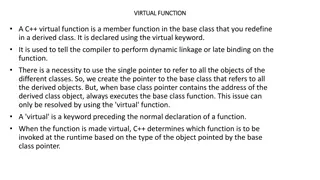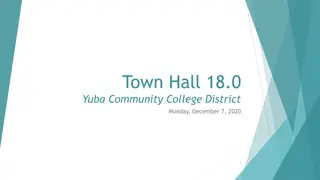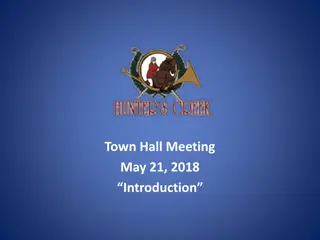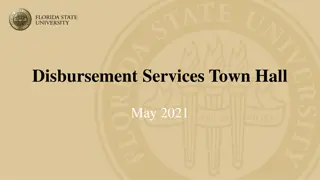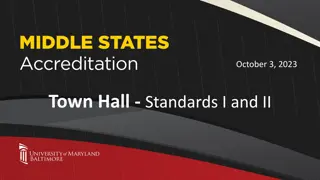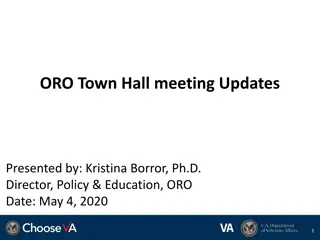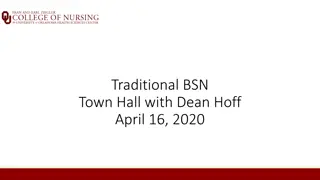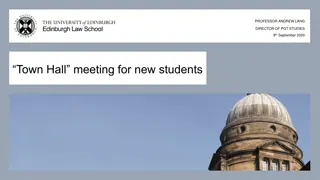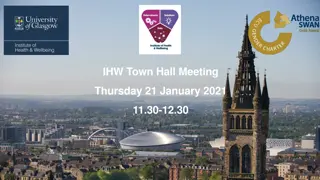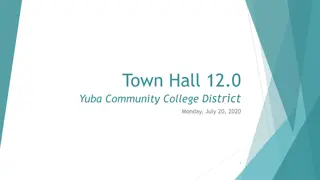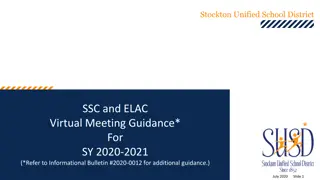Virtual Town Hall Meeting Summary May 14, 2020
Interim Chancellor Katherine Newman and other key university officials provided updates on financial matters, discussed the Federal CARES Act, and outlined plans for the upcoming academic year. A detailed financial update was presented, covering revenue and expenses for Boston campus before and after the COVID-19 impact. The meeting included discussions on gross tuition and fees, expenses, and operating margins for the university from FY2015 to FY2025.
Download Presentation

Please find below an Image/Link to download the presentation.
The content on the website is provided AS IS for your information and personal use only. It may not be sold, licensed, or shared on other websites without obtaining consent from the author.If you encounter any issues during the download, it is possible that the publisher has removed the file from their server.
You are allowed to download the files provided on this website for personal or commercial use, subject to the condition that they are used lawfully. All files are the property of their respective owners.
The content on the website is provided AS IS for your information and personal use only. It may not be sold, licensed, or shared on other websites without obtaining consent from the author.
E N D
Presentation Transcript
Virtual Town Hall Meeting May 14, 2020 Presented by: Katherine Newman, Interim Chancellor Kathleen Kirleis, Vice Chancellor for Administration and Finance Marie Bowen Vice-Chancellor for Human Resources Katherine Lynch, Assistant Vice-Chancellor, Enrollment Management Garrett Smith, Deputy Chancellor Emily McDermott, Interim Provost and Vice Chancellor of Academic Affairs Marcelo Su rez-Orozco, Chancellor Elect
Agenda Introduction Financial Update Federal CARES Act Student Federal CARES Act Support Planning for Fall Academic/Research Summer and Fall Planning Greetings from Dr. Marcelo Su rez-Orozco
4 Boston: Revenue & Expenses Before COVID-19 ($ in Thousands) Revenues BOSTON Actual Budget FY2020 247,982 (65,926) 26.6% 182,056 56,211 3,962 13,621 3,101 144,708 38,863 442,523 Q1 Projection FY2020 249,051 (66,612) Forecast % Change FY21-25 FY2015 213,968 232,355 240,235 (44,311) (45,471) 20.7% 19.6% 169,657 186,884 48,561 53,927 4,197 3,709 9,211 5,965 854 2,837 110,295 117,987 33,347 35,093 376,122 406,402 3.9% FY2016 FY2017 FY2018 243,760 (57,790) 23.7% 185,970 56,212 4,072 5,199 1,758 135,605 37,773 426,589 FY2019 245,734 (64,836) 26.4% 180,898 53,536 4,312 12,315 2,218 140,659 42,529 436,467 FY2021 254,086 259,768 265,599 271,585 277,729 (71,089) (76,200) (77,966) 28.0% 29.3% 29.4% 182,997 183,567 187,634 56,211 56,211 56,211 4,312 4,312 4,312 14,781 15,008 15,237 2,743 4,687 4,687 150,425 155,628 160,949 39,882 41,641 41,793 451,352 461,054 470,823 2.0% 2.1% FY2022 FY2023 FY2024 FY2025 Cumulative Avg. Annual 9.3% 14.9% 5.1% 7.1% 0.0% 0.0% 4.9% 70.9% 14.3% 5.3% 8.7% Gross Tuition & Fees Tuition Discounts Discount Rate Net Tuition & Fees Grants Sales & Service, Educational Auxiliary Enterprises Other Operating State appropriations Other NonOperating Total Revenues % Growth 2.2% 4.2% 2.0% 1.5% 0.0% 1.6% 2.5% 5.7% 3.4% 1.5% 2.0% (53,820) 22.4% 186,415 58,201 3,979 6,167 1,818 130,157 36,597 423,334 (79,784) 29.4% 191,801 56,211 4,312 15,378 4,687 166,417 41,967 480,771 (81,658) 29.4% 196,071 56,211 4,312 15,512 4,687 172,009 41,986 490,787 26.7% 182,438 56,211 4,312 14,107 2,743 145,190 40,646 445,647 2.1% 8.1% 4.2% 0.8% 2.3% 1.4% 2.1% 2.1% 2.1% Expenses Actual Budget FY2020 268,359 101,938 17,180 33,578 21,468 442,523 Q1 Projection FY2020 272,711 101,053 17,983 33,238 20,662 445,647 Forecast % Change FY21-25 FY2015 244,755 95,721 FY2016 266,100 101,713 16,047 18,988 9,064 411,912 FY2017 275,330 98,250 16,161 22,246 12,476 424,463 FY2018 269,465 98,972 17,180 24,433 14,152 424,202 FY2019 269,723 98,428 17,983 28,010 16,823 430,967 FY2021 273,615 99,591 17,983 35,029 20,620 446,838 FY2022 279,620 99,071 17,983 38,081 19,379 454,134 FY2023 283,720 100,192 17,983 40,696 18,815 461,406 FY2024 291,285 101,354 17,983 42,231 18,303 471,156 FY2025 299,991 102,384 17,983 42,705 17,908 480,972 Cumulative Avg. Annual 9.6% 2.8% 0.0% 21.9% -13.2% 7.6% Salaries & Fringe Non-personnel Scholarships and fellowships 12,254 Depreciation Interest Total Expenses % Growth 2.2% 0.1% 0.9% 4.7% -3.7% 1.7% 16,572 8,133 377,435 8.6% 9.1% 3.0% -0.1% 1.6% 2.7% 3.4% 1.0% 1.6% 1.6% 2.1% 2.1% Operating Margin Actual Budget FY2020 442,523 442,523 Q1 Projection FY2020 445,647 445,647 Forecast % Change FY21-25 FY2015 379,257 377,435 1,822 FY2016 406,543 411,912 (5,369) -1.3% FY2017 421,462 424,463 (3,001) -0.7% FY2018 426,589 424,202 2,387 FY2019 434,863 430,967 3,896 FY2021 451,352 446,838 4,514 FY2022 461,054 454,134 6,919 FY2023 470,823 461,406 9,416 FY2024 480,771 471,156 9,615 FY2025 490,787 480,972 9,816 Cumulative Avg. Annual 8.7% 7.6% 117.5% UMass OM Calc Revenues Total Expenses Surplus / (Deficit) UMass OM Calc 2.0% 1.7% 33.1% 0 1 0.5% 0.6% 0.9% 0.0% 0.0% 1.0% 1.5% 2.0% 2.0% 2.0%
5 Financial Implications of COVID-19 Beginning mid-March the University began assessing the financial impact of COVID-19 Initial efforts focused on estimating the value of room & board adjustments; including the timing and logistics for implementation Process initiated to gather preliminary estimates for the impact; when reviewed in conjunction with latest year-end projection, initial solutions developed Analysis of Federal CARES Act continues to assess both the impact and timing
6 Preliminary Estimate: Impact of Refunding Room and Board Preliminary refunding of 100% of student fees for unused dining was calculated to be $1.7M. Preliminary Refunding Impact (Dollars in Thousands) First Day 01/21/20 05/07/20 01/27/20 05/22/20 01/21/20 05/07/20 01/21/20 05/09/20 Exams End Spring Break Ends 3/20 Ends 3/20 Ends 3/13 Ends 3/13 Weeks Remain Estimated Refund (2) 42,700 1,694 10,977 15,753 71,124 Campus Amherst Boston (1) Dartmouth Lowell Total Weeks 16 17 16 16 7 9 8 8 (1) Does not reflect Boston P3 housing (2) Does not reflect that some students will stay on campus and may not receive any refund
7 UMB Actual Impact of Room and Board Adjustment Estimated Adjustment Gross Adjustment Less: Institutional Aid Adjustment Net Adjustment P3 Housing Adjusment* $ 1,694 1,524 $ $ $ (245) 1,279 $ 2,500 *P3 Housing Adjustment approved by Provident Commonwealth Education Resources, Inc. Board of Directors and administered by residence halls operator, COCM
8 Preliminary Estimate: FY20 Operating Margin Impact Preliminary estimates as of 4/3/2020 that were shared with the Board of Trustees; does not include an assumption for Federal CARES funding. Q2 FY2020 PROJECTION (as of 12/31/2019) COVID-19 IMPACT: PRELIMINARY ESTIMATES (as of 4/3/2020) (Dollars in Thousands) Total Revenue 1,378,046 440,609 255,658 502,402 130,921 2,707,635 Total Expenses 1,357,814 440,609 255,658 499,626 127,861 2,681,567 Room & Board (1) (41,650) (1,694) (10,977) (14,620) (68,941) Other Impacts (13,800) (717) 2,473 (510) (628) (13,182) Total Impacts (55,450) (2,411) (8,504) (15,130) Initial Solutions 15,500 2,411 2,000 6,785 2,432 29,128 Operating Margin $ (19,718) Operating Margin % Campus Amherst Boston Dartmouth Lowell President's Office Subtotal OM$ 20,232 OM% 1.5% 0.0% 0.0% 0.6% 2.3% 1.0% -1.5% 0.0% -2.7% -1.1% 3.7% -1.0% 0 0 26,068 0 (6,504) (5,569) 4,864 (26,927) 2,776 3,060 - (628) (82,123) Medical School (2) 910,033 3,537,250 887,599 3,488,748 22,434 48,502 2.5% 1.4% (68,941) - (41,472) (54,654) (41,472) (123,595) 20,520 49,648 1,482 (25,445) 0.2% -0.7% Total (1) Estimate of refunds with an assumption for students who may remain on campus and not receive a refund (2) UMMS is evaluating the costs of supporting clinical affiliates, partnering with State emergency response teams, developing new research & expanding manufacturing in response to critical needs.
Subsequent FY2020 COVID19 Impact Update The impact of COVID-19 on the university s budget continues to evolve. As more facts became known in April, the COVID-19 impact was updated. COVID-19 IMPACT: UPDATED ESTIMATES (as of 5/1/2020) (Dollars in Thousands) Room & Board (1) (1,524) Other Impacts Total Impacts (1,861) CARES Act Workforce Strategies Other Solutions 3,285 Total Solutions 3,385 Campus Boston (1) Actuals for refunds processed net of students remaining on campus. (3,385) 0 100 Reasons for this update were: Auxiliary/Other/ESS: -$1.4 million (further refinement of revenue loss from Dining & Parking, ESS, Health Services, and Other small Auxiliary) Vacation Liability: -1.5 million Further Non personnel reduction: $1.9 million This value will continue to be updated until the university s books are closed for FY20
UMB FY20 Third Quarter Projection (dollars in thousands) Revenues BOSTON Variance (Projection to Budget) Budget FY2020 247,982 (65,926) 182,056 56,211 3,962 13,621 3,101 144,708 38,863 442,523 Q3 Projection FY2020 Actual FY2019 245,734 (64,836) 180,898 53,536 4,312 12,315 2,218 140,659 42,529 436,467 Actual FY2018 242,813 (56,844) 185,970 56,212 4,072 5,199 1,758 135,605 37,773 426,589 FY2020 240,917 250,573 (68,841) 172,076 41,474 1,857 10,346 1,692 102,102 37,190 366,737 $ % Gross Tuition & Fees Tuition Discounts Net Tuition & Fees Grants Sales & Service, Educational Auxiliary Enterprises Other Operating State appropriations Other NonOperating Total Revenues 2,591 (3,647) (1,056) (6,442) (2,062) (3,275) (989) 927 843 (12,054) 1.0% 5.5% -0.6% -11.5% -52.0% -24.0% -31.9% 0.6% 2.2% -2.7% (69,573) 181,000 49,769 10,346 145,635 39,706 430,469 1,900 2,112 (dollars in thousands) Expenses BOSTON Variance (Projection to Budget) Budget FY2020 268,359 101,938 17,180 33,578 21,468 442,523 Q3 Projection FY2020 270,152 91,580 17,983 32,384 18,369 430,469 Actual FY2019 269,723 98,428 17,983 28,010 16,823 430,967 Actual FY2018 269,464 98,973 17,180 24,433 14,152 424,202 FY2020 189,580 78,913 15,804 23,864 15,114 323,276 $ % Salaries & Fringe Non-personnel Scholarships and fellowships Depreciation Interest Total Expenses 1,793 (10,358) 803 (1,194) (3,099) (12,055) 0.7% -10.2% 4.7% -3.6% -14.4% -2.7% Operating Margin UMass OM Calc Revenues Total Expenses Surplus / (Deficit) UMass OM Calc 442,523 442,523 430,469 430,469 (12,054) (12,055) -2.7% -2.7% 434,863 430,967 3,896 0.9% 426,589 424,202 2,387 0.6% 0 0 0.0% 0.0%
Closing the FY20 deficit & ending FY20 with a balanced budget FY20 budget was projected to be balanced as of Q3 with higher Tuition & Fee than budgeted offsetting higher personnel costs. COVID 19 impacts changed that in the following ways: Revenue Losses/Expense Increases: Auxiliaries: UHS, Parking & Dining Revenue Funds: ESS (loss of departmental business)/RTF (diminished grant activity) Accruals: vacation/sick liability accrual increase Solutions to get back to balance: Reduction in costs due to remote instruction/employment Utilities, shuttle buses, janitorial services, travel expenses Non personnel spending limitation to essential spending only/early close of new requisitions/reduced ProCard limits Reduction in personnel costs Hiring chill, reduction in temporary and student workers
Staffing Measures Affecting Balanced FY20 Budget Pre-COVID-19 Contributions to Balanced Budget VSIP Highly paid non-unit salary increase freeze $560,000 Total Amount $2.2M $2.76M COVID-19 Response Actions Hiring chill $342,013 03 Reductions $250,000 Net student worker reductions $275,160 Total amount $867,173 Unanticipated Vacation Liability Senior staff contribution Union negotiations $1.5M
13 FY21 Budget Planning New Planning Timeline Update to the Board of Trustees on COVID-19 impact April 2020 Initial Budget to be Adopted by Board of Trustees June 2020 Start of UMB Fiscal Year, Essential Spending Only July 2020 Ongoing planning and consultation with faculty and staff Summer 2020 FY21 Updated Budget Adopted by Board of Trustees September 2020 FY21 budgets issued September 2020
14 FY21 Revenue Budget Planning Practically Every Budgeted Revenue Line Item Faces Challenge and Uncertainty: Tuition and Fees Dependent on enrollment Rates to be frozen for FY21 State Appropriation state is experiencing a decline in tax revenues Sales and Services, Educational (ESS) largely dependent on amount of activity on campus Grants Uncertainty around availability of governmentally-funded research Uncertainty from private grantors Auxiliary Services - largely dependent on amount of activity on campus
15 FY21 Planning Approach UMB completed 5-year financial forecast in December of 2019; this was the basis of that reflected the planning assumptions that were used as the FY21 budget process started Revenue budget will be developed to determine what steps need to be planned regarding expenses Some budget planning assumptions are controlled by the University; where possible, those have been reviewed and updated. Other assumptions are still uncertain. To be able to plan for so much uncertainty, a variety of scenarios are being prepared and reviewed to assess operational and fiscal impact Scenarios for operations are presently being developed by various committees. Some of these options will then be incorporated into the budget as more is known about the timing and extent of any activities that can be returned to campus safely Scenarios have to allow the university to achieve a balanced budget
FY21 Updated Planning Parameters Forecast Baseline Changes 5% reduction 0.0% No increase No increase No increase No increase Decided? (Yes or TBD) (presented December 2019) Revenue Assumptions State Appropriation State Collective Bargaining Modeled Tuition: In State UG Modeled Tuition: Out of State UG Modeled Tuition: Grad Enrollment 0.0% 2.0% Yes: per state guidance Yes Yes Yes Yes 2.5% increase Up to 3% increase Up to 3% increase 1% increase in online only Expense Assumptions Collective Bargaining Fringe Rate Payroll Tax 2.0% 37.12% 2.60% 0.0% 37.12% 2.60% Yes: per state guidance Yes Yes Operating Margin 1.0% Planning for 0% Yes
Additional Fiscal Planning Scenarios for FY21 Scenario Brief Description A Tuition: Baseline Out of state & grad State appropriation: 5%, 10%, 20% reduction Enrollment: 5%, 10% reduction Enrollment: No international Freeze tuition B Reduce funding, including fringe, by 5%,10% & 20% Reduce for all categories by 5% & 10% for the full year (impacts tuition, housing & dining) No international students (impacts tuition, housing & dining) Assume remote learning for half the fall semester; reduce housing & dining revenue C D E Remote Learning: 50% housing & dining for fall semester Remote Learning: 0% housing & dining for fall semester F Assume remote learning for all fall semester; no housing & dining revenue
Additional State Appropriation Reductions Scenarios FY20 Allocation FY20 TOTAL Amherst 268,155,200 99,373,792 63,840,557 87,829,585 40,854,857 - 560,053,991 Boston Dartmouth Lowell Worcester Central Total FY21 Scenarios - 10% 10% State Reduction Fringe Impact Total Impact Amherst (26,815,520) (9,937,379) (6,384,056) (8,782,959) (4,085,486) - (56,005,399) (9,929,787) (3,679,811) (2,364,016) (3,252,330) (1,512,855) - (20,738,799) (36,745,307) (13,617,191) (8,748,072) (12,035,288) (5,598,341) - (76,744,198) Boston Dartmouth Lowell Worcester Central Total FY21 Scenarios - 15% 15% State Reduction Fringe Impact Total Impact Amherst (40,223,280) (14,906,069) (9,576,084) (13,174,438) (6,128,229) - (84,008,099) (14,894,681) (5,519,717) (3,546,024) (4,878,494) (2,269,283) - (31,108,199) (55,117,961) (20,425,786) (13,122,107) (18,052,932) (8,397,512) - (115,116,298) Boston Dartmouth Lowell Worcester Central Total FY21 Scenarios - 20% 20% State Reduction Fringe Impact Total Impact Amherst (53,631,040) (19,874,758) (12,768,111) (17,565,917) (8,170,971) - (112,010,798) (19,859,574) (7,359,623) (4,728,032) (6,504,659) (3,025,711) - (41,477,599) (73,490,614) (27,234,381) (17,496,143) (24,070,576) (11,196,682) - (153,488,397) Boston Dartmouth Lowell Worcester Central Total 18
Next steps in the FY2021 Budget Process Continue to develop scenario planning Evaluate and update budget plans as key components of the revenue budget are finalized Evaluate and update budget plans as operational decisions for Fall 2020 semester are made Continue to educate and provide transparency about the university s financial position as it develops and seek input as the process moves forward with Key university leaders (Faculty Council, Executive Leadership Team, Department Chairs, Union Leaders, Student Leaders) Faculty Budget and Long Range Planning Committee F&A Committee, Operations Planning Committees Campus community
CARES Act Funding for Higher Education The Coronavirus Aid, Relief, & Economic Security Act signed by the President on 3/27/20 Governor s Education Relief Fund ($2.95 billion) (Both higher ed. & K- 12) 90% ($12.5 billion) awarded through formula (75% Pell recipient enrollment, 25% non-Pell enrollment) Education Stabilization Appropriation ($30.75 billion) Higher Education Emergency Relief Fund ($14.24 billion) CARES Act ($2 trillion) 7.5% ($992 million) to HBCUs and MSIs Elem. & Secondary Ed. Emergency Relief Fund ($13.5 billion) (Granted to states, 90% sub-granted to local districts) 2.5% ($331 million) to small institutions with unmet need
22 US Department of Education (DOE): Allocation of 90% Funding Share ($12.5B) CARES Act Stimulus Funding U.S. DOE utilized the most recent data from the Integrated Postsecondary Education Data System (IPEDS) and Federal Student Aid (FSA) for this allocation. Funds are being distributed immediately in two tranches: 50% dedicated to student aid and 50% for institutional support. Eligible costs include: a student s cost of attendance, such as food, housing, course materials, technology, healthcare, and child care. (Dollars in Thousands) Minimum for Emergency Financial Aid to Students Estimated Total Stimulus Campus Amherst Boston Dartmouth Lowell Medical School Total 18,335 12,185 6,288 8,900 310 46,019 9,168 6,092 3,144 4,450 155 23,009 Source: U.S. Department of Education
23 Use of Stimulus Funds for Institutional Costs $6.092M for UMass Boston Institutions are given wide discretion to address costs associated with significant changes to the delivery of instruction due to COVID-19 Funds can be used for applicable COVID-19 related costs incurred during the one year period beginning March 13, 2020 Eligible costs include: Refunds to students for room and board, tuition, and other fees Technology costs to bolster and support transition to distance learning Additional financial aid grants to students Other costs associated with COVID-19 If demonstrably related to disruption to instruction, scholarships for FY21 Funds cannot be used for students exclusively enrolled online, contracted pre-enrollment recruiting activities, endowments, or capital outlays related to athletics Spending cannot exceed the amount of student grant awards made
Student Federal CARES Act Support
CARES Act Overview UMass Boston will receive ~$6 million in federal funding for direct student aid Federal CARES Act provided over $12 billion in funding to higher education institutions (HEERF) Each institution s allocation is divided evenly into an institutional share and a student share UMass Boston has received ~$6m for the student share, including ~$49k for MSI status US DOE has established guidance for the use of the student share, including: Funds are intended to be direct grant aid to students for expenses related to the disruption of campus operations due to COVID-19 Allowable expenses include food, housing, course materials, technology, healthcare, childcare Funds cannot be used to pay institutional balances and must go directly to students Funds must be spent within one year; we aim to spend funds by the end of the calendar year Students must be eligible for federal financial aid funds to qualify for CARES aid We are committed to doing everything we can to provide equitable funding for students who are not eligible under CARES Act Recent gifts to Beacon Student Aid Fund and Immigrant Student Fund will help support this work Staff will coordinate funding to make sure students are connected to appropriate resources 25
We have implemented an application-based model that allows students with COVID-related expenses to apply for aid during 3-4 windows Application Process Students submit a simple web application to indicate their expenses through checkboxes Application should take no more than 2 minutes to complete and can be completed on a smartphone Marketing & Communications Multiple campus-wide emails have been sent to students, faculty, and staff Link on umb.edu homepage, coronavirus FAQ page, and social media channels Collaboration with affinity groups, campus partners, and student organizations to promote the application Funding Windows Our model estimates the share of funds to be disbursed in each funding window, providing milestones but also enabling flexibility to adjust our strategy if needed based on demand or evolving guidance Exceptions will be considered outside of application windows to meet immediate needs. Students should be directed to The One Stop for assistance 26
Model reflects pace of spending and target audiences throughout calendar year; timing and amounts can be adjusted May/June 2020 August 2020 October 2020 December 2020 Students enrolled in spring semester or summer I/II Graduating students* Students returned from study abroad Students with technology challenges Continuing students enrolled in fall or with financial hardships preventing fall registration New incoming students with technology or housing challenges Students enrolled in fall semester after add/drop (new and continuing) Students with technology challenges Continuing students enrolled or trying to enroll in spring Graduating students* (December grad) New incoming students with technology challenges Target student groups (illustrative examples) High need: $1,200 Moderate need: $600 Low need: $300 High need: $1,000 Moderate need: $500 Low need: $250 High need: $1,000 Moderate need: $500 Low need: $250 High need: $800 Moderate need: $400 Low need: $200 Funding tiers Students served ~3,000 students (~28% of eligible) ~3,600 students (~34% of eligible) ~3,600 students (~34% of eligible) ~1,500 students (~15% of eligible) Funding target ~$1.8m disbursed (30% of total funds) ~$1.8m disbursed (30% of total funds) ~$1.8m disbursed (30% of total funds) ~$0.6m disbursed (10% of total funds) *Graduating students are likely only eligible until they graduate (May 29) - any disbursement made to these students will need to happen within the next month 27
Students have indicated additional expenses related to food, connectivity, and technology related to campus disruption As of Tuesday, May 12, 2,430 students had applied for CARES Act funding Qualifying Expenses Indicated by Applicants 2000 1734 1673 1600 1345 1256 1145 1200 800 404 400 158 0 Food Connectivity Technology Materials/Supplies Housing Healthcare Childcare % of Applicants 7% 71% 69% 55% 52% 47% 17% Note: Data as of 12pm on 5/12/20; students could select multiple expenses
Some assumptions in our planning for the fall 1. We will prioritize student, faculty, staff and community health and well-being. 2. We will ensure that when decisions to reopen partially (and beyond) have been made that we are assured of PPE supplies, cleaning at a rigorous standard, and all social distancing provisions are both feasible and followed. 3. We will prioritize students progress toward their degrees. 4. If/when on-campus activities resume, risk will exist, so we must create options for students and staff. 5. All of our decisions will be based on guidance from public health & government authorities. 30
We are actively planning for several possible fall scenarios Scenario 1: Scenario 2: Scenario 3: Scenario 4: REMOTE HYBRID of on campus and remote ON CAMPUS with social distancing Things return to NORMAL 31
We are actively planning for several possible fall scenarios Scenario 1: Scenario 2: Scenario 3: Scenario 4: REMOTE HYBRID of on campus and remote ON CAMPUS with social distancing Things return to NORMAL How to do better? How? How? UNLIKELY 32
Campus activities may return in different ways at different times Scenario 2: Scenario 3: Scenario 1: ON CAMPUS with social distancing HYBRID of on campus and remote REMOTE A. Work / Campus Operations B. Coursework / Academic program C. Campus life and services D. Residence Halls E. Research 33
Two key questions will drive which activities are highest priority to return to campus YES Highest priority to resume on campus 1 Is social distancing feasible? Lowest priority to resume on campus NO LESS MORE How important is it to occur in person / on campus? 2 34
And a critical third question will determine how many activities return to campus YES 1 3 Is it safe for any of these activities to return to campus? Is social distancing feasible? NO LESS MORE How important is it to occur in person / on campus? 2 35
A set of committees is diving deep on these planning efforts Safety & Recovery Academics 1 2 Co-chairs: Director of Environmental Health & Safety and Manager of Emergency Planning Members: Human Resources, UHS, Facilities, UMBPD, ODEI, Communications Chair: VC of Academic Affairs Members: Deans, Faculty, IT, Registrar, Facilities Research & Scholarship Campus Life 3 4 Chair: VC of Student Affairs Members: Dean of Students, Facilities, Campus Services, Athletics, IT, UHS, Emergency Management, Students Chair: VC of Academic Affairs & Vice Provost of Research Members: Deans, Faculty, IT, ORSP, EHS, Facilities Human Resources CARES Act 5 6 Chair: VC of Human Resources Members: A&F, Academic Affairs, Chancellor s Office Co-chairs: Assistant VC of Enrollment Management, Special Assistant to the Chancellor Members: A&F, Student Affairs, Grad Studies, Academic Support Services, Government Affairs 7 Enrollment & Student Success Chair: VC of Enrollment Management Members: Admissions, Grad Studies, IR, Budget & Financial Planning, Financial Aid, Academic Support Services, Registrar, Dean of Students 36
Academic/Research Summer and Fall Planning
Planning for Academic and Research Continuity Deans Council Planning Process to date Spring 2020 student accommodations, faculty accommodations and trainings, research ramp- down Summer 2020 decision to go remote; faculty opt-out; faculty training availability Preliminary fact-finding to inform scenarios for Fall. Next phase of planning (now through summer) Academic Continuity Committee: to include Deans Council reps, faculty reps, Faculty Council/college governance/BLRP reps, FSU/DCU reps, A&F reps Planning structures still TBD (subject in part to impact bargaining with FSU and DCU) Goals: To develop and refine nimble evidence-based AY2020-21 scenarios To assure students a top-quality academic experience To make recommendations regarding best academic practice, training opportunities for faculty Research Continuity Committee: to include Deans Council reps, faculty reps, governance reps Update: NTT Non-Reappointments
Greetings from Dr. Marcelo Su rez-Orozco
Questions? Chancellor@umb.edu


